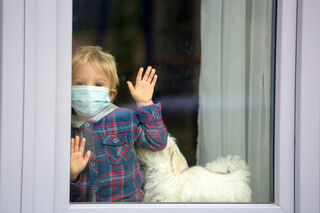Fear
'My Kid Won't Go Back to School!': These 4 Letters Are Why
FOGO, or fear of going out, is the newest psychological struggle for children.
Posted April 6, 2021 Reviewed by Jessica Schrader
Key points
- FOGO, or fear of going out, is the newest childhood fear.
- FOGO is normal for kids who have adapted to quarantine.
- FOGO isn't about tolerating risk, it's about tolerating uncertainty and discomfort—so strategies to combat FOGO should focus on tolerating uncertainty and discomfort.
- There are four simple steps to take to help your child learn to deal with FOGO.
Is FOGO the New Child Health Crisis?
We’ve been looking forward to returning to “normal” since we first heard the word “COVID,” saw the schematic of the crown-shaped molecule, learned about mask hygiene, or first heard the phrase “social distancing,” right? School being back in session should be exciting—both for adults and kids, right? After all, humans thrive on social interaction, not social distancing. Distance learning has been quite educational—in terms of just how frustrating education can get, not in terms of actual academic subjects covered. And most of us miss the world.
But for some kids, FOGO is the new watchword. Now that “going out” is starting to become a distinct possibility, some kids are actively resisting any return to semblances of normality.
I don’t get it. Dina’s distress comes through clearly, even over our teletherapy hookup. He’s never had a problem with school refusal before. He spoke cheerfully about when it would be OK to go back to school, how much he misses his friends, and how nice it would be to see people again. But now that his school is offering an in-person option, he’s adamantly refusing. And it’s not only school. My parents are now vaccinated, and we wanted to have an in-person visit, but he stayed home. He claims he’s not scared to go out, but shows no interest in anything—he won’t come along for a car ride, he doesn’t want to ride his bike, and he shows no interest in resuming safe, socially distanced activity. Right now, in-person schooling isn’t mandated – he can still learn remotely—but that option will disappear one day. What do I do? It’s like he’s entirely comfortable at home and he’s lost all consciousness of a world outside our front door. It doesn’t even make sense—my husband and I are vaccinated, as are all the teachers in his school. He had a mild case of COVID, so he likely has immunity. The school has great protocols … It’s perfectly safe. What is he so afraid of?

Dina’s not alone. Her son Jacob has FOGO. He’s not clinically anxious—or at least, he wasn’t before the pandemic. He isn’t expressing a specific fear of going out—he claims not to be worried about COVID—he’s just lost interest in all outdoor pursuits. He has a social life, of sorts, over Zoom, he’s keeping up with his schooling. He can even get outdoor play in Dina’s backyard. He just feels completely disinclined to rejoin the world. While Dina’s chomping at the bit to resume some sense of normalcy, he’s adapted to a quarantine lifestyle totally.
Humans Are Adaptive
Humans can adapt to almost any circumstance. That’s why we have safety mechanisms like smoke detectors. If the smell of smoke creeps up on us slowly, our brains habituate, and we don’t notice. We can get used to almost anything, and almost anything can seem normal after a while. In the Handmaid’s Tale, Margaret Atwood’s dystopian tale of a future American under the rule of a fundamentalist dictatorship, we meet Aunt Lydia. She is an “Aunt,” a female authority figure charged with re-educating women to handle the new world order. This is a world in which women have no rights, and pretty much everything we know about society is upended. She tells the female characters known as handmaids:
“Ordinary is what you are used to. This may not seem ordinary to you now, but after a time it will. It will become ordinary.”
As evil as she is in the story, Aunt Lydia has a good point. This is how the human brain functions. What was new, scary, and restrictive can become “normal,” once we adapt to it.
For Jacob, quarantine has become normal. He has adapted successfully to this life circumstance, and he’s unwilling to change it. Going out into the world, being an in-person student again, visiting grandparents, and even a Target run—these are the abnormal circumstances he’s being asked to deal with. To our brains, abnormal stimuli are threatening.
Seeking Safety
After all, the home environment is safe. The world is almost entirely predictable at home. Jacob has learned certain coping tools. If the kids in his class are getting too overwhelming, he can minimize the school tab. You can’t do that in the real world! Talking to Grandma and Grandpa over Zoom gives Jacob a certain amount of control that an in-person interaction simply doesn’t have. Even a Target run carries risks, right?
Many people view anxiety as an inability to tolerate risk. Imagine a child who is wrestling with the decision about whether or not to go on a roller coaster. On the one hand, he hears his siblings talk about how much fun it is. He sees people stagger off the roller coaster, looking a bit shaken, but happy, laughing and talking about the best ride of their lives. On the other hand, the roller coaster looks so tall. The dips look so steep. The loops look so scary.
Is it really risk he’s thinking about? Is the child thinking about the statistical likelihood of the rollercoaster failing, the likelihood of engineering failure, or stress factors on the metal holding the ride together? It’s more likely fear of uncertainty—he doesn’t know what the ride will feel like. Maybe it will be good. But maybe he’ll throw up. Maybe he’ll love it, like his brothers do. But maybe it will be intolerably uncomfortable, and he’ll be trapped.
When Dina argues with Jacob regarding the safety of returning to school or a more “normal” form of life, she’s speaking in the language of risk—she’s pointing out that a return to school is relatively low risk, that most concerns have been thought of by the adults and addressed. She’s not speaking the language of uncertainty and discomfort. She’s focused on the wrong barriers.
Dina needs to talk to Jacob’s uncertainty concerns, the way she would about any other childhood fear. In her mind, this isn’t a classic childhood fear, like fear of the dark or fear of dogs, because prior to COVID, Jacob lived a “normal” life in the world. He went to school, thought nothing of a visit to Grandma or a Target run, and loved going on playdates. In her mind, Jacob is returning to something known and familiar.
But in Jacob’s mind, the mind of a child who has adapted to quarantine, this is all new and scary, exactly like any other trigger that sparks a childhood phobia—anything from a loudly barking dog to a roller coaster, to going to school for the first time. It feels entirely new, scary, and unsafe. Jacob has lost the ability to predict what these challenges are like, and he’s not willing to tolerate uncertainty.
Like many kids with developmentally appropriate fears, he is more resistant to discomfort than logically weighing risks. Dina would do better to focus her coaching on the very real discomfort Jacob is feeling. Here are the steps Dina should take:
- Validate the Valid: “I get that returning to school feels scary. I bet a lot of people feel that way. New things often feel scary.”
- Name It to Tame It: Dan Siegel and Tina Payne Bryson’s pithy phrase reminds us that emotion naming and emotion leveling can really help cut fears down to size. Having Jacob talk about his fears, and be detailed about specific ones, can help bring them down to size. This is especially helpful when coupled with leveling emotions—on a scale of one to 10, how scary is it? What’s the worst part?
- Problem-Solve: Now that we know what you’re scared of, let's come up with a plan to handle each challenge. Let’s come up with solutions that work for each part of the challenge, until we have a workable plan.
- Take Baby Steps: If going back to school full-time seems overwhelming, how about driving by the school building first, going by when the building is empty, and then gradually getting used to actually going inside? If a full visit to Grandma is too much, how about a doorway visit that’s time-limited? Take it slow, to give the child’s brain to adapt to the new-new-normal.
The fact that our brains are adaptive is a good thing. Let’s capitalize on that strength to help kids with FOGO learn to gradually feel comfortable rejoining the world. Don’t worry—before we know it, we’ll be overscheduled and grumbling about FOMO again.




